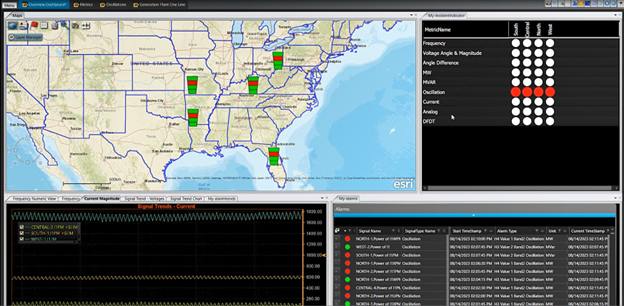
Securing the U.S. Electric Power Grid
ARPA-E OPEN 2018 program performer University of Wisconsin – Madison (UW-Madison), in collaboration with Washington State University and Electric Power Group (EPG), developed a real-time monitoring system of the electric grid using a unique approach called “persistence” measure which is used to monitor power system oscillations. The team also developed tools to detect and locate the source of forced oscillations in the power grid using Phasor Measurement Units (PMU).
Oscillations are cyclic variations in power system metrics such as frequency, voltages, currents, and power flows. Persistent, significant oscillations in the power grid often indicate instability and can be predictive of brownouts or blackouts in extreme cases. These incidents are not often isolated and can spread throughout the grid, damaging power system equipment and impacting system reliability.
There is an increasing need for technologies that alert grid operators of such oscillations so operators can respond in real time. It is useful to monitor system damping (or decay) from ambient data so operators can detect the possibility of a vulnerability before the grid becomes unstable. In addition, it is also essential to detect the presence and location of forced oscillations. These are initiated by an incorrectly operating component or controller that causes an oscillatory signal at a single location on the grid.
To address these needs, the team developed a new “persistence” measure that can assess noisy ambient data to measure system damping. Persistence measures the duration of a system impulse response when the grid is disturbed by some event. In addition, data from PMUs, which can provide data at 30 frames/second (or higher), is captured at a fast enough rate to quickly detect and locate forced oscillations. The team uses data-only and model-enhanced triangulation approaches to detect and locate oscillations for operators.
The team has already utilized their software in real-world applications. EPG, a subrecipient on this project, is a software vendor that supports control room applications for major utilities and grid operators with experience using PMU data for real-time monitoring and stability analysis. EPG has incorporated the software updates created by this project into their Phasor Grid Dynamics Analyzer (PGDA) software and their Real Time Dynamics Monitoring System (RTDMS). The online monitory system prototype has also been operating at Bonneville Power Administration’s Synchrophasor laboratory.
This project enables the integration of more renewable energy sources into the power grid without compromising grid stability which would reduce the dependence on thermal power plants for electricity generation and the harmful emissions that can come from these plants. This project’s successful completion paves the way for a technology-to-market transition that will enable more economical and secure operation of the power grid through detection and remediation of unstable grid oscillations. Operational cost savings could top $1 billion per year worldwide.
UW-Madison’s approach could dramatically transform grid stability monitoring by increasing system confidence and economic efficiency in a nearly $400 billion U.S. industry.
